trailer CHEVROLET BLAZER 1994 2.G Owners Manual
[x] Cancel search | Manufacturer: CHEVROLET, Model Year: 1994, Model line: BLAZER, Model: CHEVROLET BLAZER 1994 2.GPages: 348, PDF Size: 17.88 MB
Page 56 of 348
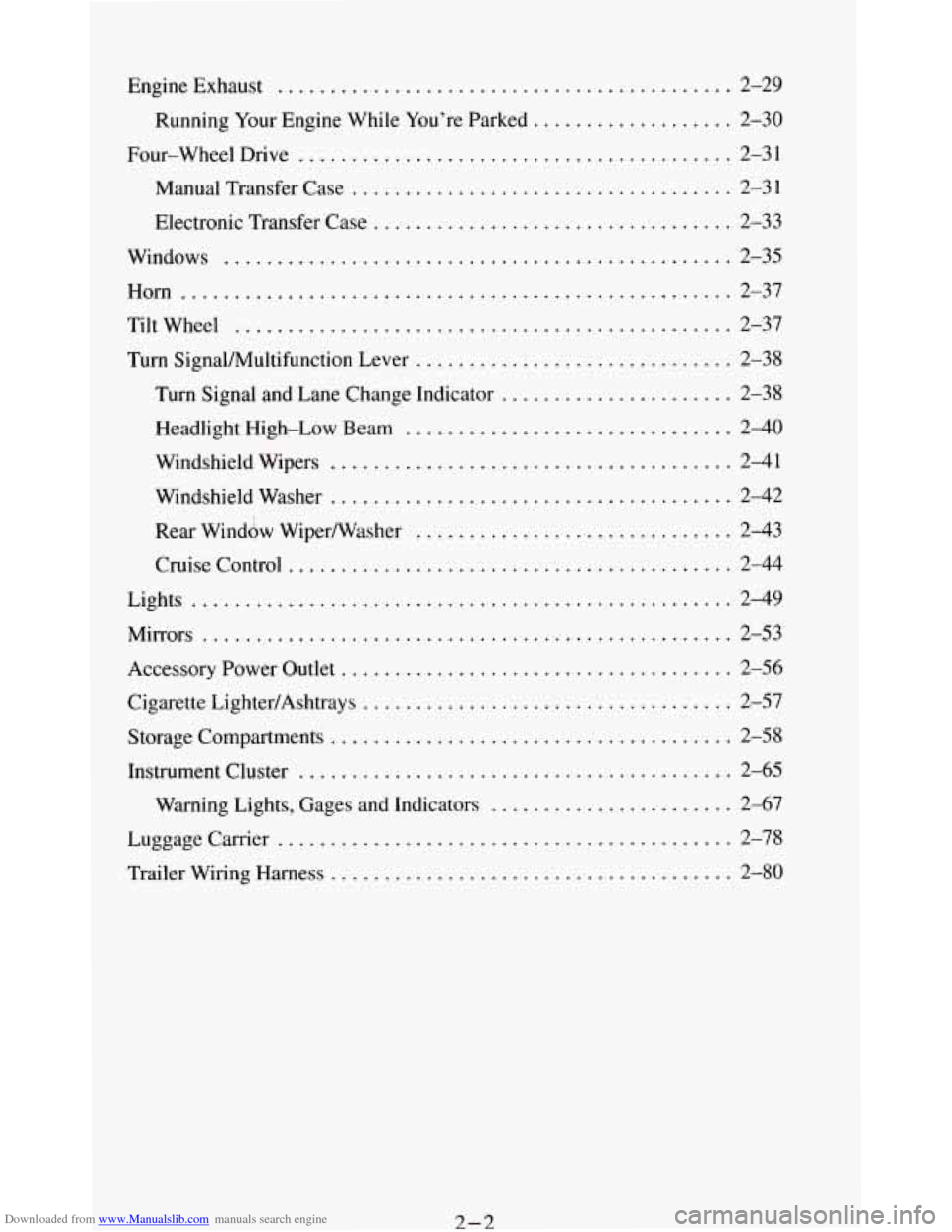
Downloaded from www.Manualslib.com manuals search engine EngineExhaust ........................................... 2-29
Running Your Engine While You’re Parked
................... 2-30
Four-WheelDrive
......................................... 2-31
Manual Transfer Case
.................................... 2-31
Electronic Transfer Case
.................................. 2-33
Windows
................................................ 2-35
Horn
.................................................... 2-37
Tiltwheel
............................................... 2-37
Turn Signal/Multifunction Lever
.............................. 2-38
Turn Signal and Lane Change Indicator
...................... 2-38
Headlight High-Low Beam
............................... 2-40
Windshield Wipers
...................................... 2-41
Windshield Washer
...................................... 2-42
Rear Window Wiper/Washer
.............................. 2-43
Cruise Control
.......................................... 2-44
Lights
................................................. 2-49
Mirrors
.................................................. 2-53
Accessory Power Outlet
..................................... 2-56
Cigarette LightedAshtrays
................................... 2-57
Storage Compartments
...................................... 2-58
Instrument Cluster ......................................... 2-65
Warning Lights. Gages
and Indicators ....................... 2-67
Luggagecarrier
........................................... 2-78
Trailer Wiring Harness
...................................... 2-80
2-2
Page 76 of 348
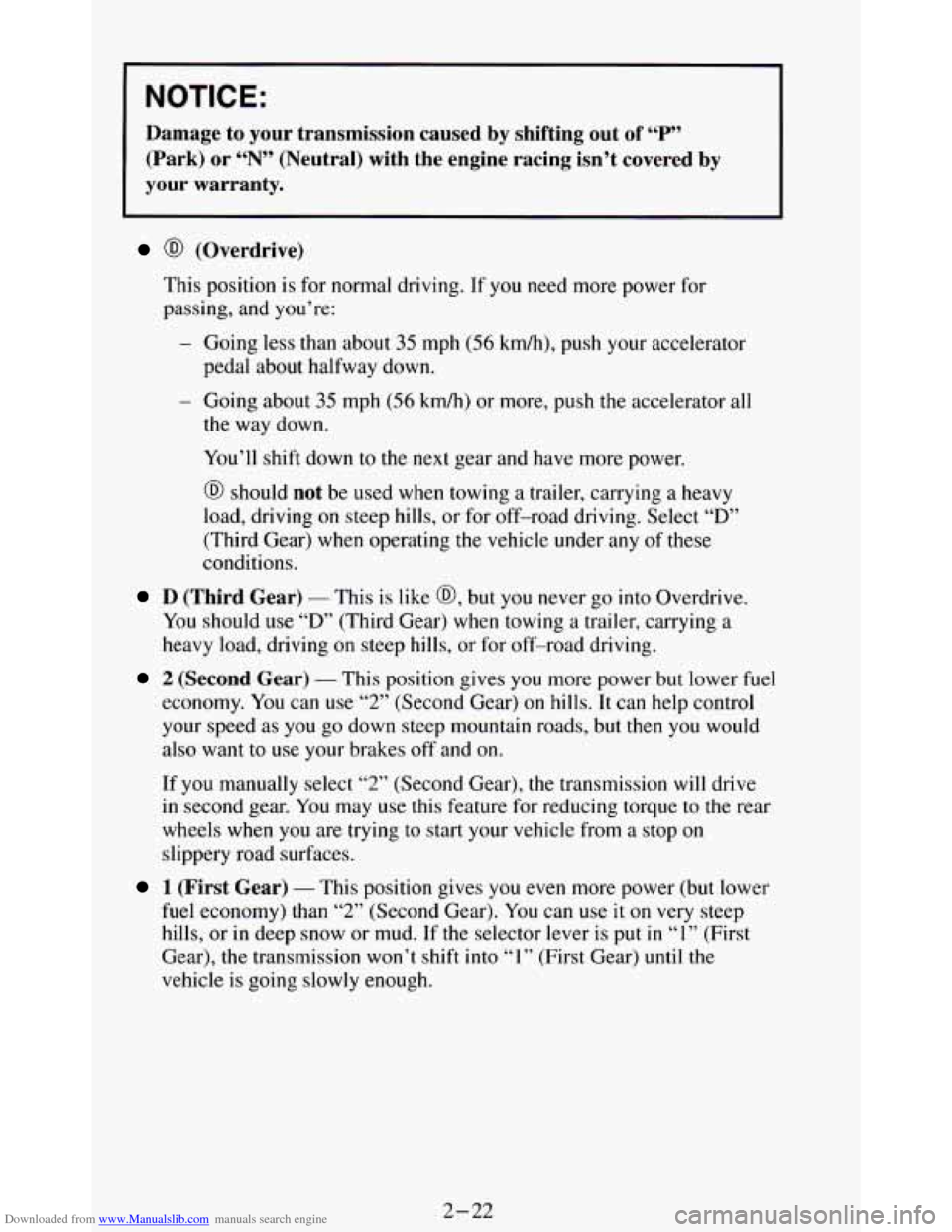
Downloaded from www.Manualslib.com manuals search engine NOTICE:
Damage to your transmission caused by shifting out of “P”
(Park) or “N” (Neutral) with the engine racing isn’t covered by
your warranty.
@ (Overdrive)
This position is for normal driving. If you need more power for
passing, and you’re:
- Going less than about 35 mph (56 km/h), push your accelerator
- Going about 35 mph (56 km/h) or more, push the accelerator all
pedal about halfway down.
the way down.
You’ll shift down to the next gear and have more power.
@ should not be used when towing a trailer, carrying a heavy
load, driving
on steep hills, or for off-road driving. Select “D”
(Third Gear) when operating the vehicle under any of these
conditions.
D (Third Gear) - This is like @, but you never go into Overdrive.
You should use
“D’ (Third Gear) when towing a trailer, carrying a
heavy load, driving on steep hills,
or for off-road driving.
2 (Second Gear) - This position gives you more power but lower fuel
economy. You can use “2” (Second Gear) on hills. It can help control
your speed as you go down steep mountain roads, but
then you would
also want to use your brakes
off and on.
If you manually select
“2” (Second Gear), the transmission will drive
in second gear. You may use this feature for reducing torque to the rear
wheels when
you are trying to start your vehicle from a stop on
slippery road surfaces.
1 (First Gear) - This position gives you even more power (but lower
fuel economy) than “2” (Second Gear). You can use it on very steep
hills, or in deep snow or mud. If the selector lever is put
in “1” (First
Gear),
the transmission won’t shift into “1” (First Gear) until the
vehicle
is going slowly enough.
2-22
Page 80 of 348
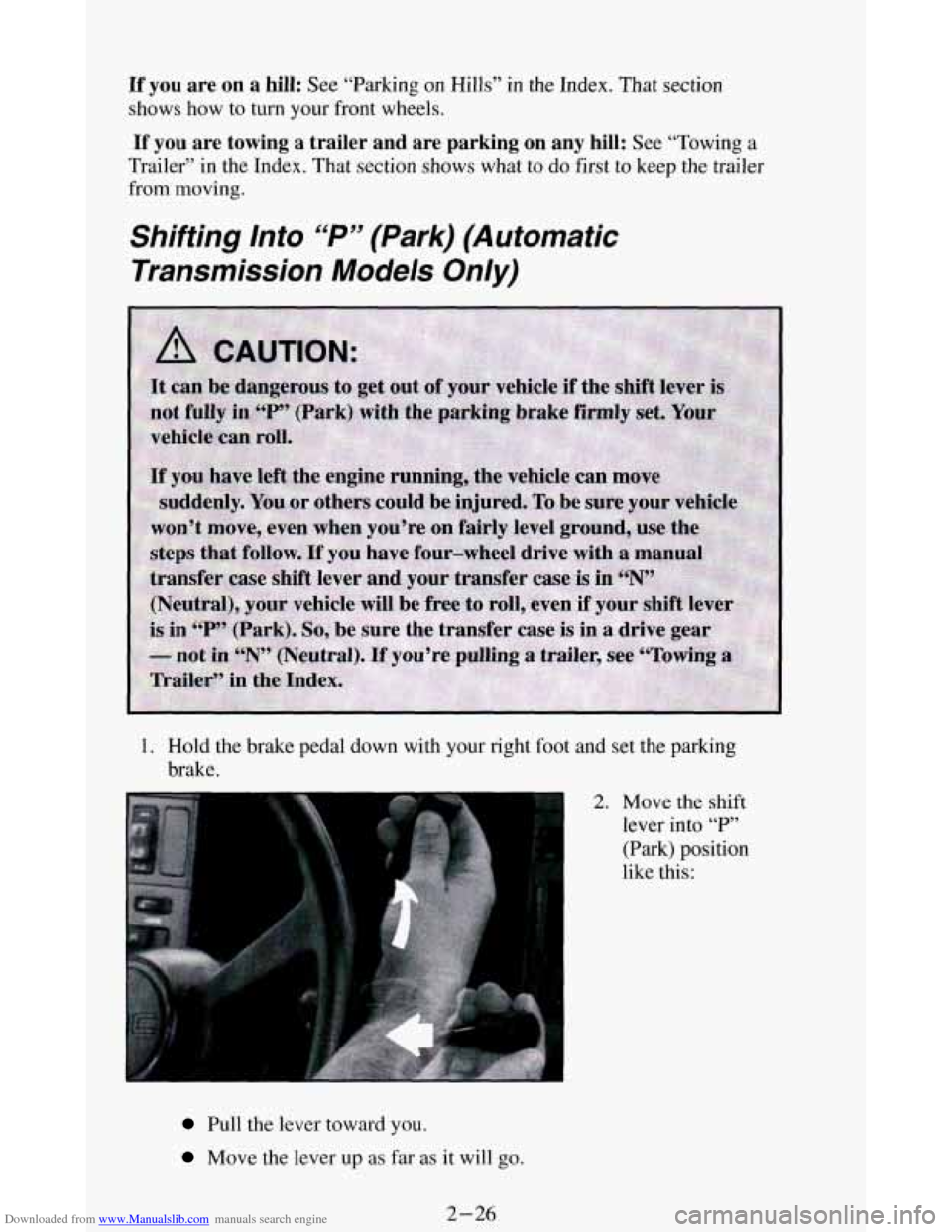
Downloaded from www.Manualslib.com manuals search engine If you are on a hill: See “Parking on Hills” in the Index. That section
shows how to turn your front wheels.
If you are towing a trailer and are parking on any hill: See “Towing a
Trailer” in the Index. That section
shows what to do first to keep the trailer
from moving.
Shifting /nto “P” (Park) (Automatic
Transmission
Models On/y)
1. Hold the brake pedal down with your right foot and set the parking
brake.
2. Move the shift
lever into
“P”
(Park) position
like this:
Pull the lever toward you.
Move the lever up as far as it will go.
2-26
Page 82 of 348
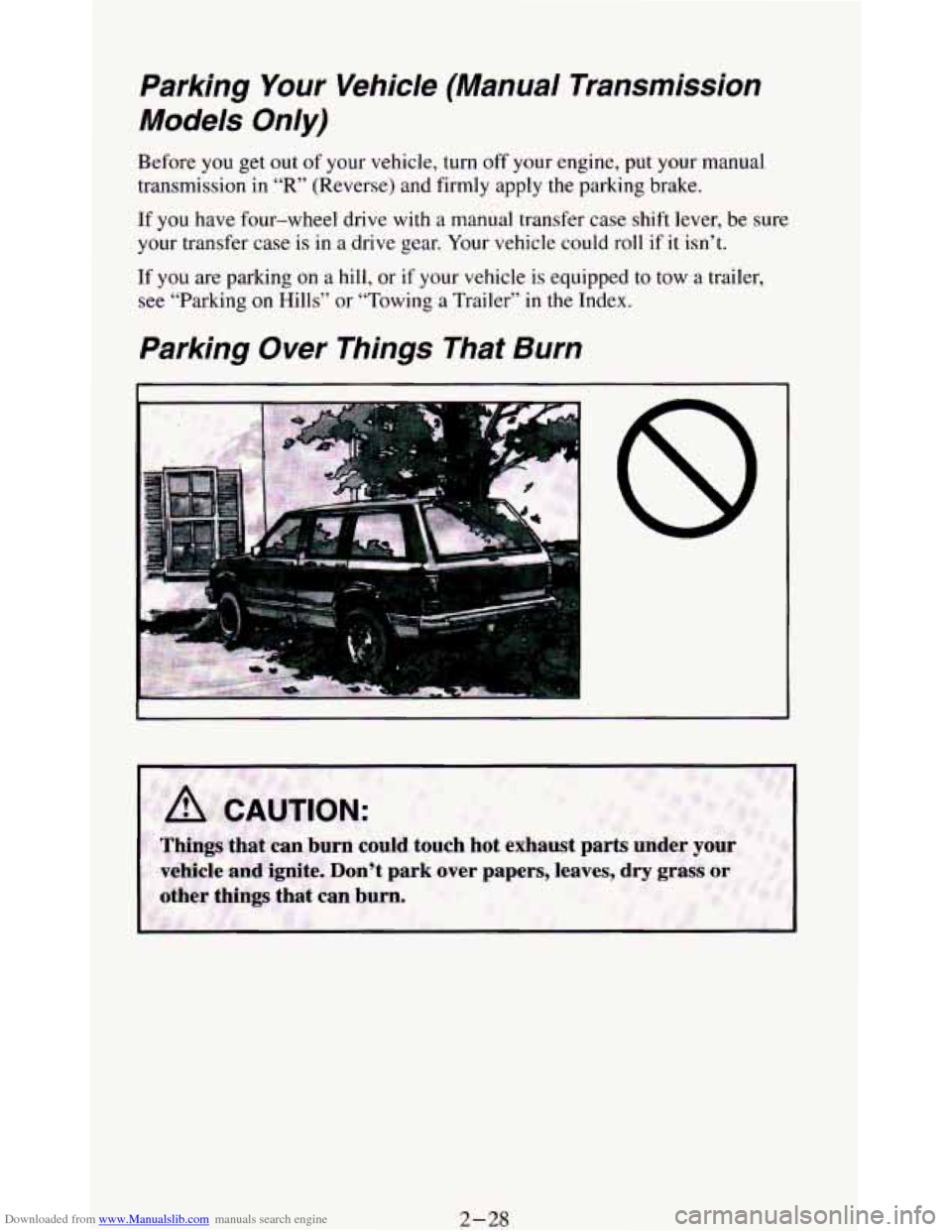
Downloaded from www.Manualslib.com manuals search engine Parking Your Vehicle (Manual Transmission
Models Only)
Before you get out of your vehicle, turn off your engine, put your manual
transmission
in “R” (Reverse) and firmly apply the parking brake.
If you have four-wheel drive with a manual transfer case shift lever, be sure
your transfer case is in
a drive gear. Your vehicle could roll if it isn’t.
If you are parking on a hill, or if your vehicle is equipped to tow a trailer,
see “Parking on Hills” or “Towing a Trailer”
in the Index.
Parking Over Things That Burn
2-28
Page 84 of 348
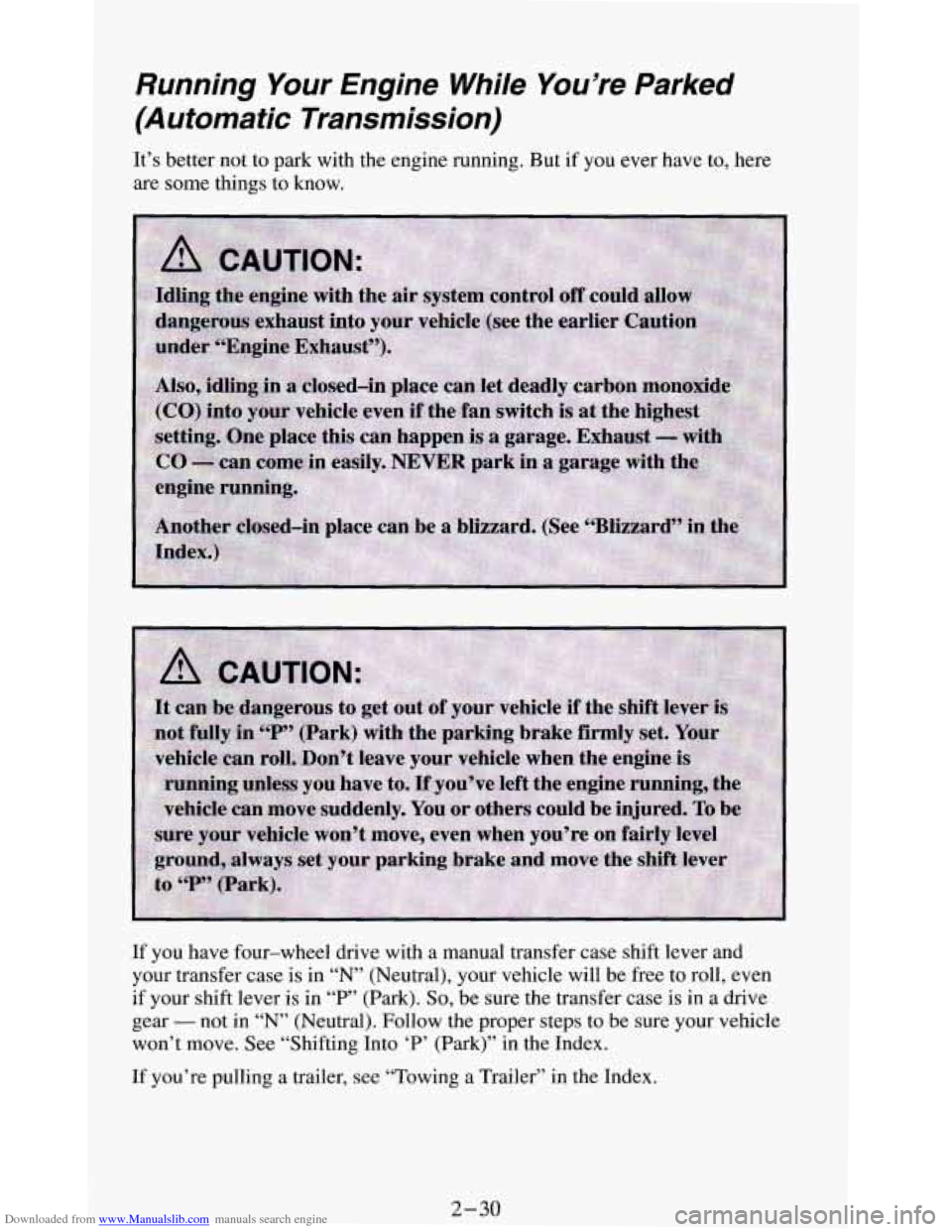
Downloaded from www.Manualslib.com manuals search engine Running Your Engine While You’re Parked
(Automatic Transmission)
It’s better not to park with the engine running. But if you ever have to, here
are some things to know.
If you have four-wheel drive with a manual transfer case shift lever and
your transfer case is in “N” (Neutral), your vehicle will be free to roll, even
if your shift lever is in
“P” (Park). So, be sure the transfer case is in a drive
gear
- not in “N’ (Neutral). Follow the proper steps to be sure your vehicle
won’t move. See “Shifting Into ‘P’ (Park)” in the Index.
If you’re pulling a trailer, see “Towing a Trailer” in the Index.
2-30
Page 93 of 348
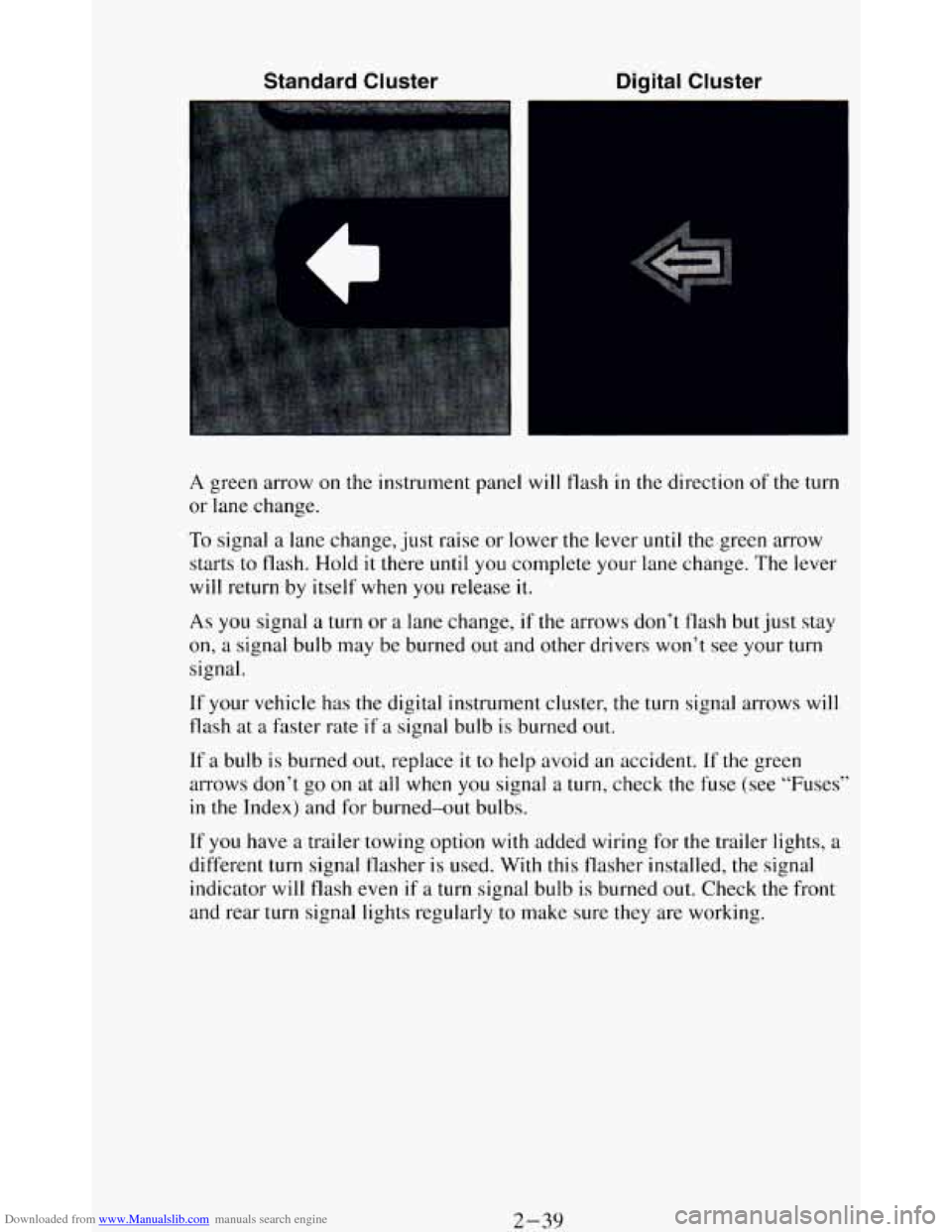
Downloaded from www.Manualslib.com manuals search engine Standard Cluster Digital Cluster
A green arrow on the instrument panel will flash in the direction of the turn
or lane change.
To signal
a lane change, just raise or lower the lever until the green arrow
starts to flash. Hold
it there until you complete your lane change. The lever
will return by itself when you release it.
As you signal a turn or a lane change, if the arrows don’t flash but just stay
on,
a signal bulb may be burned out and other drivers won’t see your turn
signal.
If your vehicle has the digital instrument cluster, the turn signal arrows will
flash at
a faster rate if a signal bulb is burned out.
If a bulb is burned out, replace it to help avoid an accident. If the green
arrows don’t go on at all when you signal a turn, check the fuse (see “Fuses”
in the Index) and for burned-out bulbs.
If
you have a trailer towing option with added wiring for the trailer lights, a
different turn signal flasher is used. With this flasher installed, the signal
indicator will flash even if
a turn signal bulb is burned out. Check the front
and rear turn signal lights regularly to make sure they are working.
2-39
Page 134 of 348
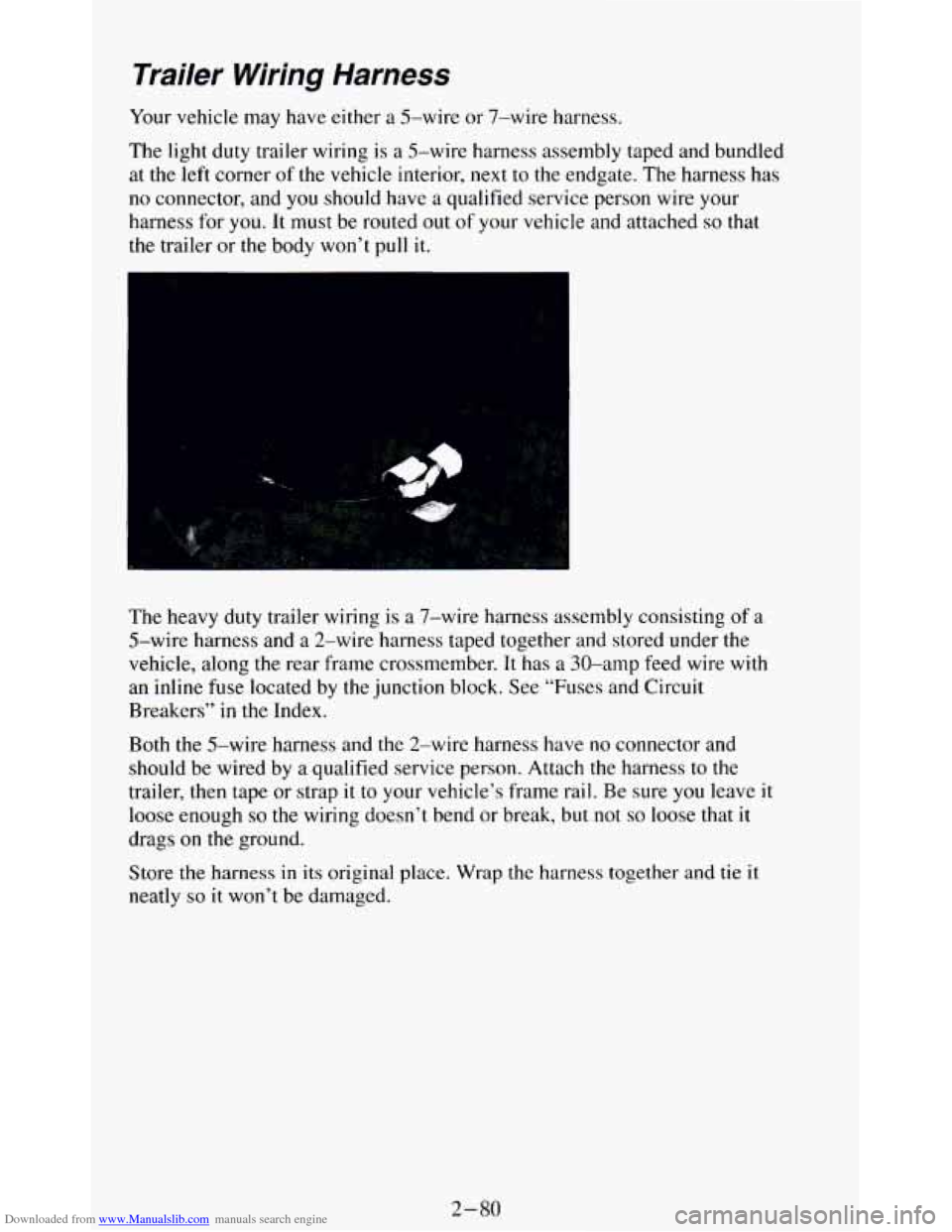
Downloaded from www.Manualslib.com manuals search engine Trailer Wiring Harness
Your vehicle may have either a 5-wire or 7-wire harness.
The light duty trailer wiring is a 5-wire harness assembly taped and bundled
at the left corner
of the vehicle interior, next to the endgate. The harness has
no connector, and you should have a qualified service person wire your
harness for
you. It must be routed out of your vehicle and attached so that
the trailer or the body won’t pull
it.
The heavy duty trailer wiring is a 7-wire harness assembly consisting of a
5-wire harness and a 2-wire harness taped together and stored under the
vehicle, along
the rear frame crossmember. It has a 30-amp feed wire with
an inline fuse located by the junction block. See “Fuses and Circuit
Breakers” in the Index.
Both the 5-wire harness and the 2-wire harness have no connector and
should be wired by a qualified service person. Attach the harness to the
trailer, then tape or strap
it to your vehicle’s frame rail. Be sure you leave it
loose enough so the wiring doesn’t bend or break, but not so loose that it
drags
on the ground.
Store the harness in its original place.
Wrap the harness together and tie it
neatly so it won’t be damaged.
2-80
Page 159 of 348
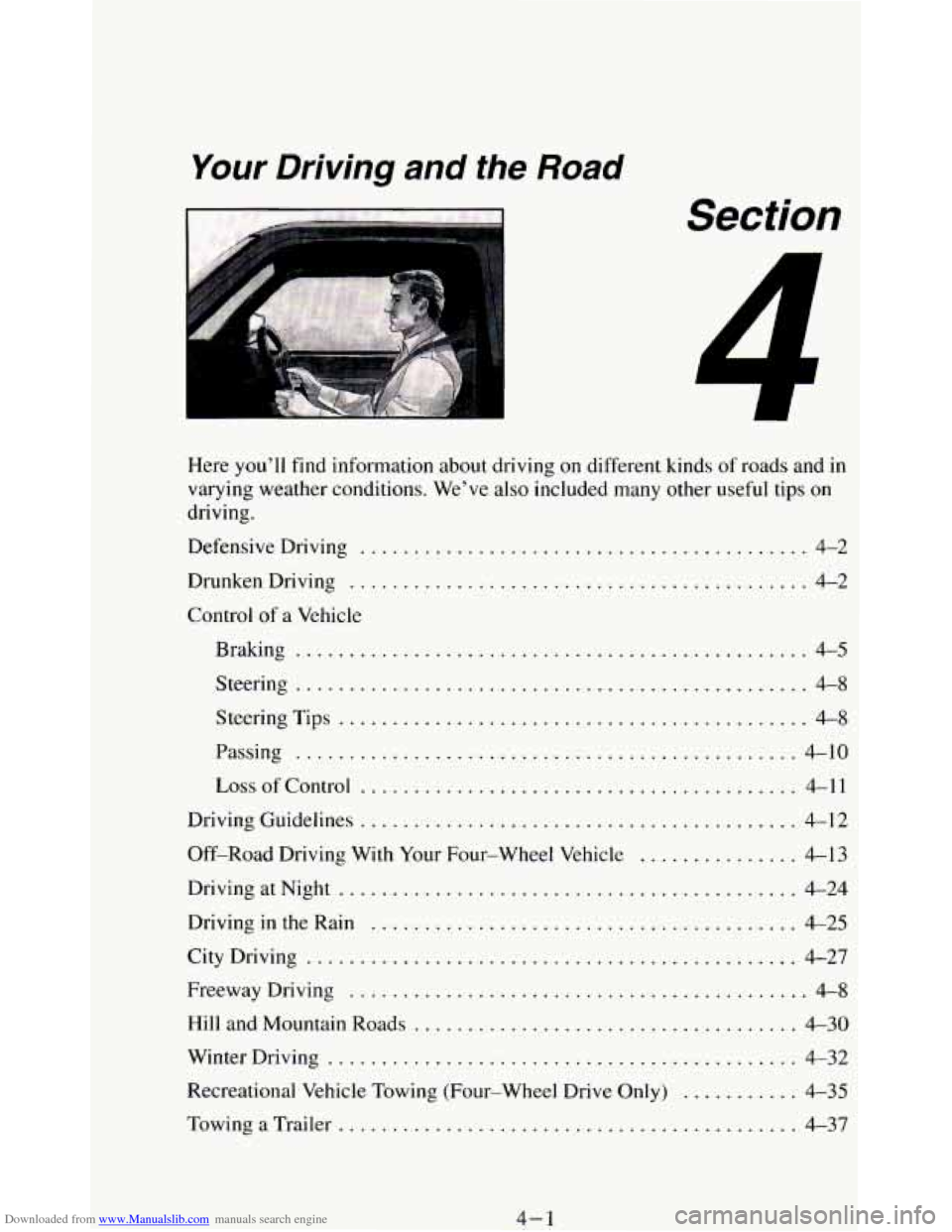
Downloaded from www.Manualslib.com manuals search engine Your Driving and the Road
Section
Here you'll find information about driving on different kinds of roads and in
varying weather conditions . We've also included many other useful tips on
driving
.
Defensive Driving ..................... ................. 4-2
DrunkenDriving ........................................... 4-2
Braking ................................................ 4-5
Steering Tips ............................................ 4-8
Control
of a Vehicle
Steering
................................................ 4-8
Passing
............................................... 4-10
Loss of Control ......................................... 4-11
Driving Guidelines
......................................... 4-12
Off-Road Driving With Your Four-wheel Vehicle
............... 4-13
DrivingatNight ........................................... 4-24
Driving
in the Rain ........................................ 4-25
Freeway Driving
........................................... 4-8
Hill and Mountain Roads
.................................... 4-30
Winter Driving
............................................ 4-32
CityDriving
.............................................. 4-27
Recreational Vehicle Towing (Four-wheel Drive Only)
........... 4-35
TowingaTrailer
........................................... 4-37
4-1
Page 195 of 348
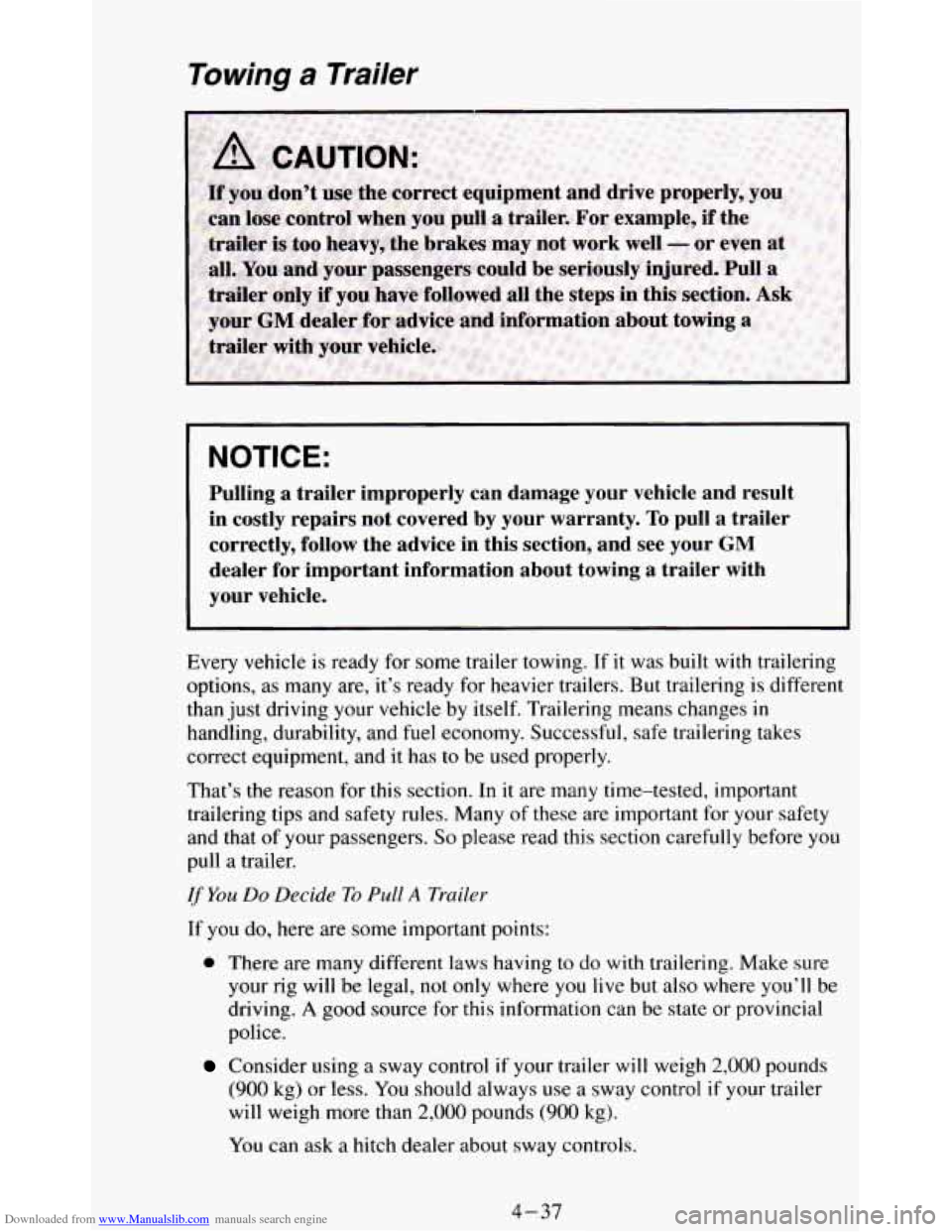
Downloaded from www.Manualslib.com manuals search engine Towing a Trailer
NOTICE:
Pulling a trailer improperly can damage your vehicle and result\
in costly repairs not covered by your warranty.
To pull a trailer
correctly, follow the advice in this section, and see your
GM
dealer for important information about towing a trailer with
your vehicle.
Every vehicle is ready for some trailer towing. If it was built with trailering
options, as many are, it’s ready for heavier trailers. But trailering
is different
than just driving your vehicle by itself. Trailering means changes
in
handling, durability, and fuel economy. Successful, safe trailering takes
correct equipment, and it has to be used properly.
That’s the reason for this section.
In it are many time-tested, important
trailering tips and safety rules. Many of these are important for your safety
and that of your passengers.
So please read this section carefully before you
pull
a trailer.
If You Do Decide To Pull A Trailer
If you do, here are some important points:
0 There are many different laws having to do with trailering. Make sure
your rig will be legal, not only where you
live but also where you’ll be
driving.
A good source for this information can be state or provincial
police.
Consider using a sway control if your trailer will weigh 2,000 pounds
(900 kg) or less. You should always use a sway control if your trailer
will weigh more than
2,000 pounds (900 kg).
You can ask a hitch dealer about sway controls.
4-37
Page 196 of 348
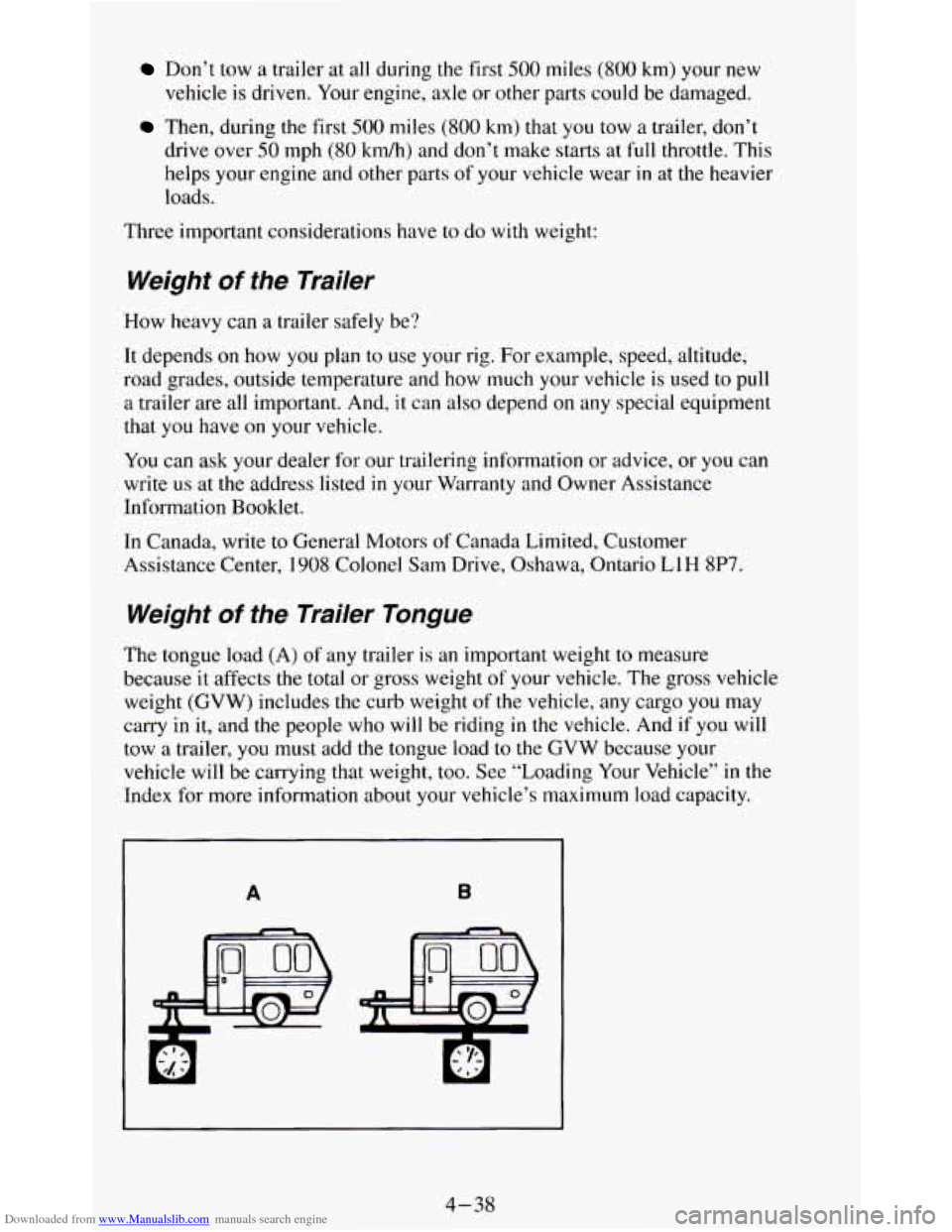
Downloaded from www.Manualslib.com manuals search engine Don’t tow a trailer at all during the first 500 miles (800 km) your new
vehicle
is driven. Your engine, axle or other parts could be damaged.
Then, during the first 500 miles (800 km) that you tow a trailer, don’t
drive over
50 mph (80 km/h) and don’t make starts at full throttle. This
helps your engine and other parts
of your vehicle wear in at the heavier
loads.
Three important considerations have
to do with weight:
Weight of the Trailer
How heavy can a trailer safely be?
It depends on how you plan to use your rig. For example, speed, altitude,
road grades, outside temperature and how much your vehicle
is used to pull
a trailer are all important. And,
it can also depend on any special equipment
that
you have on your vehicle.
You can ask your dealer for our trailering information or advice, or
you can
write
us at the address listed in your Warranty and Owner Assistance
Information Booklet.
In Canada, write to General Motors
of Canada Limited, Customer
Assistance Center,
1908 Colonel Sam Drive, Oshawa, Ontario LlH 8P7.
Weight of the Trailer Tongue
The tongue load (A) of any trailer is an important weight to measure
because it affects the total or gross weight of your vehicle. The gross vehicle
weight (GVW) includes
the curb weight of the vehicle, any cargo you may
carry in it, and the people who will be riding
in the vehicle. And if you will
tow
a trailer, you must add the tongue load to the GVW because your
vehicle will be carrying
that weight, too. See “Loading Your Vehicle” in the
Index for more information about your vehicle’s maximum load capacity.
B A
4-38